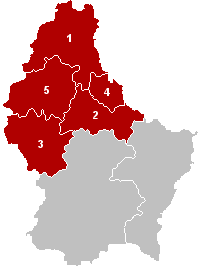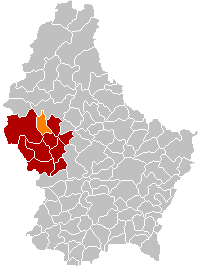
The three districts of Luxembourg were the top-level administrative divisions of the Grand Duchy of Luxembourg. The districts were further subdivided into cantons, which still exist:

The District of Diekirch was one of three districts of the Grand Duchy of Luxembourg. Immediately prior to its abolition on 3 October 2015, it contained five cantons divided into 43 communes:
- Clervaux
- Diekirch
- Redange
- Vianden
- Wiltz
The 12 cantons of the Grand Duchy of Luxembourg are subdivisions at the first level of local administrative unit (LAU-1) in the European Union's Nomenclature of Territorial Units for Statistics for Eurostat purposes. They were subdivisions of the three districts of Luxembourg until 2015, when the district level of government was abolished. The cantons are in turn subdivided into 100 communes.

Redange or Redange-sur-Attert is a commune and town in northwestern Luxembourg, near the border with Belgium. It is situated in the eponymous canton of Redange. Redange is situated on the river Attert, a tributary of the Alzette.

Wahl is a former commune and small village in western Luxembourg, in the canton of Redange.

Ell is a commune and small town in western Luxembourg, in the canton of Redange. It lies close to the border with Belgium.

Luxembourg's 100 communes conform to LAU Level 2 and are the country's lowest administrative divisions.

Beckerich is a commune and small town in western Luxembourg, in the canton of Redange. It lies close to the border with Belgium.

Grosbous is a former commune and small town in northwestern Luxembourg, in the canton of Redange.

Rambrouch is a commune and small town in western Luxembourg, in the canton of Redange. It lies close to the border with Belgium.

Useldange is a commune and small town in western Luxembourg, in the canton of Redange.
The Éislek, also known by its German name Ösling or Oesling, is a region covering the northern part of both the Grand Duchy of Luxembourg and Eifelkreis Bitburg-Prüm, within the greater Ardennes area that also covers parts of Belgium and France. The Éislek covers 32% of the territory of Luxembourg; to the south of the Éislek lies the Gutland, which covers the remaining 68% of the Grand Duchy as well as the southern part of the Eifelkreis Bitburg-Prüm.

The Guttland is a region covering the southern and central parts of the Grand Duchy of Luxembourg. The Guttland covers 68% of the territory of Luxembourg; to the north of Gutland lies the Éislek, which covers the remaining 32% of the Grand Duchy. To the east, the Luxembourgish Guttland adjoins the Bitburger Gutland of Germany.

Oberpallen is a small town in the commune of Beckerich, in western Luxembourg. In 2024, the town had a population of 437.

Folschette is a small town in the commune of Rambrouch, in western Luxembourg. As of 2024, the town has a population of 490.
Perlé is a small town in the commune of Rambrouch, in western Luxembourg. As of 2024, the town has a population of 912.

The district of Mersch was one of the four districts of Luxembourg between 1857 and 1867. It took its name from its administrative centre, the town of Mersch, and contained the cantons of Mersch and Redange. It is the only district to have been created after the initial establishment, and was the only district to have been abolished before they all were in 2015.

Eschette is a village in the commune of Rambrouch and the canton of Redange in western Luxembourg. As of 2024, it has 32 inhabitants.

Eltz is a village in northwestern Luxembourg.

Haut-Martelange is a village in northwestern Luxembourg.





















